Items filtered by date: July 2025
Bunions Are a Common Cause of Foot Pain
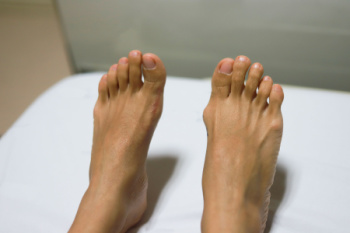
Bunions, also known as hallux valgus, are a type of mechanical foot pain that develop when the big toe shifts out of place over time. This change causes a bony bump to form at the base of the big toe, leading to discomfort and difficulty fitting into regular shoes. The pain is often made worse by standing or walking for long periods, as pressure on the joint increases. Several factors can contribute to bunion development, including inherited foot structure, wearing narrow or tight shoes, and certain foot conditions like flat feet. As the bunion grows larger, it may lead to swelling, stiffness, or even difficulty moving the big toe. Using supportive footwear and wearing custom orthotics can help ease discomfort in the early stages. If the bunion worsens, surgery may be considered. It is suggested you visit a podiatrist to discuss relief and treatment options.
Toe pain can disrupt your daily activities. If you have any concerns, contact Brian Doerr, DPM of Florida. Our doctor can provide the care you need to keep you pain-free and on your feet.
What Causes Toe Pain?
Most severe toe pain is caused due to a sports injury, trauma from dropping something heavy on the toe, or bumping into something rigid. Other problems can develop over time for various reasons.
Toe pain can be caused by one or more ailments. The most common include:
- Trauma
- Sports injury
- Wearing shoes that are too tight
- Arthritis
- Gout
- Corns and calluses
- Hammertoe
- Bunions
- Blisters
- Ingrown toenails
- Sprains
- Fractures (broken bones)
- Dislocations
When to See a Podiatrist
- Severe pain
- Persistent pain that lasts more than a week
- Signs of infection
- Continued swelling
- Pain that prevents walking
Diagnosis
In many cases the cause of toe pain is obvious, but in others, a podiatrist may want to use more advanced methods to determine the problem. These can range from simple visual inspections and sensation tests to X-rays and MRI scans. Prior medical history, family medical history, and any recent physical traumatic events will all be taken into consideration for a proper diagnosis.
Treatment
Treatments for toe pain and injuries vary and may include shoe inserts, padding, taping, medicines, injections, and in some cases, surgery. If you believe that you have broken a toe, please see a podiatrist as soon as possible.
If you have any questions please contact our office located in Fort Meyers, FL . We offer the newest diagnostic and treatment technologies for all your foot and ankle needs.
Rock Climbing and Foot Injuries
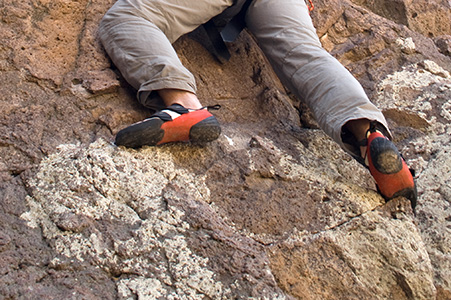
Rock climbers often experience foot injuries due to intense pressure, wearing tight footwear, and repetitive strain. Common injuries include stress fractures, tendonitis, sprains, and bruised toenails. Symptoms can range from sharp pain and swelling to numbness or reduced mobility. Risk factors include poorly fitting climbing shoes, overuse, and inadequate rest between climbs. The unique demands of climbing can lead to chronic foot issues, if not addressed early. A podiatrist can evaluate the injury, recommend supportive footwear, provide targeted treatments, and create a recovery plan to prevent recurrence. If you are a rock climber experiencing persistent foot pain or discomfort, it is suggested that you seek help from a podiatrist to ensure your feet stay strong and ready for your next climb.
Ankle and foot injuries are common among athletes and in many sports. They can be caused by several problems and may be potentially serious. If you are feeling pain or think you were injured in a sporting event or when exercising, consult with Brian Doerr, DPM from Florida. Our doctor will assess your condition and provide you with quality foot and ankle treatment.
Common Injuries
The most common injuries that occur in sporting activities include:
- Achilles Tendonitis
- Achilles Tendon Rupture
- Ankle Sprains
- Broken Foot
- Plantar Fasciitis
- Stress Fractures
- Turf Toe
Symptoms
Symptoms vary depending upon the injury and in some cases, there may be no symptoms at all. However, in most cases, some form of symptom is experienced. Pain, aching, burning, bruising, tenderness, tightness or stiffness, sensation loss, difficulty moving, and swelling are the most common symptoms.
Treatment
Just as symptoms vary depending upon the injury, so do treatment options. A common treatment method is known as the RICE method. This method involves rest, applying ice, compression and elevating the afflicted foot or ankle. If the injury appears to be more serious, surgery might be required, such as arthroscopic or reconstructive surgery. Lastly, rehabilitation or therapy might be needed to gain full functionality in the afflicted area. Any discomfort experienced by an athlete must be evaluated by a licensed, reputable medical professional.
If you have any questions please contact our office located in Fort Meyers, FL . We offer the newest diagnostic and treatment technologies for all your foot and ankle needs.
Get Professional Care for a Broken Foot or Ankle
Peroneal Tendinopathy Is a Source of Outer Ankle Pain
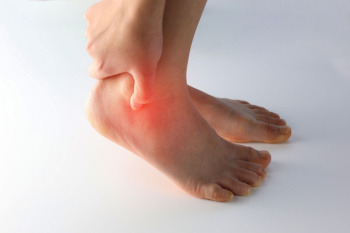
Peroneal tendinopathy is a condition involving irritation or degeneration of the peroneal tendons, which run along the outer side of the ankle and foot. These tendons help stabilize the foot and support balance during walking or running. Causes include overuse, improper footwear, high-impact activities, or ankle instability. Symptoms include aching or sharp pain along the outer ankle, swelling, weakness, or a feeling of instability. Without treatment, the condition may worsen and limit mobility. A podiatrist can evaluate the problem through physical examination and imaging, then provide care with rest plans, bracing, or custom orthotics. If you experience persistent outer ankle pain, it is suggested that you visit a podiatrist for a tailored treatment plan and long-term relief.
Ankle pain can be caused by a number of problems and may be potentially serious. If you have ankle pain, consult with Brian Doerr, DPM from Florida. Our doctor will assess your condition and provide you with quality foot and ankle treatment.
Ankle pain is any condition that causes pain in the ankle. Due to the fact that the ankle consists of tendons, muscles, bones, and ligaments, ankle pain can come from a number of different conditions.
Causes
The most common causes of ankle pain include:
- Types of arthritis (rheumatoid, osteoarthritis, and gout)
- Ankle sprains
- Broken ankles
- Achilles tendonitis
- Achilles tendon rupture
- Stress fractures
- Bursitis
- Tarsal tunnel syndrome
- Plantar fasciitis
Symptoms
Symptoms of ankle injury vary based upon the condition. Pain may include general pain and discomfort, swelling, aching, redness, bruising, burning or stabbing sensations, and/or loss of sensation.
Diagnosis
Due to the wide variety of potential causes of ankle pain, podiatrists will utilize a number of different methods to properly diagnose ankle pain. This can include asking for personal and family medical histories and of any recent injuries. Further diagnosis may include sensation tests, a physical examination, and potentially x-rays or other imaging tests.
Treatment
Just as the range of causes varies widely, so do treatments. Some more common treatments are rest, ice packs, keeping pressure off the foot, orthotics and braces, medication for inflammation and pain, and surgery.
If you have any questions please feel free to contact our office located in Fort Meyers, FL . We offer the newest diagnostic tools and technology to treat your foot and ankle needs.
The Importance of Wearing Safety Shoes at Work
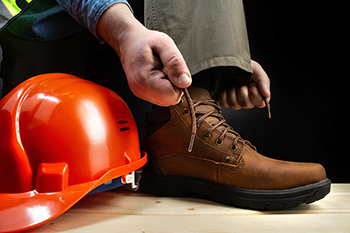
Wearing safety shoes during the workday is essential for protecting your feet from a variety of hazards. These shoes help prevent slips and falls by providing proper traction and reduce fatigue through cushioning and support. They also guard against sharp object penetration and shield your feet from harsh weather conditions. Choosing the right work shoes can make a significant difference in your comfort and safety. However, the use of improper footwear can lead to foot injuries, pain, or long-term problems. A podiatrist can assess foot injuries caused by wearing incorrect work shoes and recommend solutions, such as custom insoles or alternative footwear options. If you have injured your feet during your work day, it is suggested that you consult a podiatrist who can treat various foot conditions.
While working on the feet, it is important to take the proper care of them. For more information about working on your feet, contact Brian Doerr, DPM from Florida. Our doctor will treat your foot and ankle needs.
Working on Your Feet
Standing on your feet for long periods of time can cause stress and pain in your feet. Your whole body may experience change in terms of posture, back pain, bunions, callouses and or plantar warts. There are ways to avoid these conditions with proper foot care, smart choices and correct posture.
Positive Changes
Negative heeled shoe – Choosing this shoe type places the heel slightly lower than the ball of the foot. These are great for overall foot health. Find shoes that fit you correctly.
Go barefoot – Our feet were not designed to be enclosed for all hours of the day. Try to periodically expose your feet to air.
Eliminate Pain
Foot Exercises – Performing simple exercises, incorporating yoga and doing stretches are beneficial. This will allow increased blood flow to the area and muscles of the foot.
Achilles tendon – Stretching the foot out flat on the floor will relax the calf muscles and tendon. These exercises can be performed almost anywhere. Make sure you add these exercises to your daily regimen.
With a little bit of this information and knowing more about foot health, you will notice changes. Foot stretches and proper footwear will help with pain and prevent further issues.
If you have any questions please contact our office located in Fort Meyers, FL . We offer the newest diagnostic and treatment technologies for all your foot and ankle needs.
Exploring Negative Pressure Wound Care
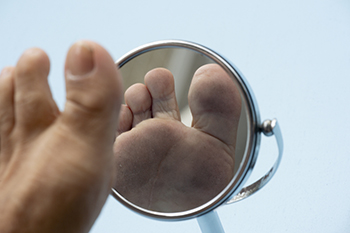
Negative pressure wound therapy applies controlled suction to non‑healing wounds on the foot, toes, or ankle to reduce excess fluid, improve blood flow, and stimulate healthy tissue formation. A podiatrist evaluates the wound’s depth, tissue condition, and surrounding skin before implementing therapy. The procedure involves using a porous dressing connected to a device that gently draws out excess fluids and encourages the wound edges to contract. This type of wound care also supports new tissue growth and promotes circulation. By removing excess fluid and proteins, the therapy helps restore proper pressure balance in the wound bed. It is most suitable for ulcers, non‑healing surgical sites, or complicated ankle wounds that have stalled in healing. Negative pressure therapy supports wound closure while it also minimizes infection risk and avoids unnecessary surgery. If you have foot wounds that will not heal, it is suggested that you schedule an appointment with a podiatrist for appropriate treatment.
Wound care is an important part in dealing with diabetes. If you have diabetes and a foot wound or would like more information about wound care for diabetics, consult with Brian Doerr, DPM from Florida. Our doctor will assess your condition and provide you with quality foot and ankle treatment.
What Is Wound Care?
Wound care is the practice of taking proper care of a wound. This can range from the smallest to the largest of wounds. While everyone can benefit from proper wound care, it is much more important for diabetics. Diabetics often suffer from poor blood circulation which causes wounds to heal much slower than they would in a non-diabetic.
What Is the Importance of Wound Care?
While it may not seem apparent with small ulcers on the foot, for diabetics, any size ulcer can become infected. Diabetics often also suffer from neuropathy, or nerve loss. This means they might not even feel when they have an ulcer on their foot. If the wound becomes severely infected, amputation may be necessary. Therefore, it is of the upmost importance to properly care for any and all foot wounds.
How to Care for Wounds
The best way to care for foot wounds is to prevent them. For diabetics, this means daily inspections of the feet for any signs of abnormalities or ulcers. It is also recommended to see a podiatrist several times a year for a foot inspection. If you do have an ulcer, run the wound under water to clear dirt from the wound; then apply antibiotic ointment to the wound and cover with a bandage. Bandages should be changed daily and keeping pressure off the wound is smart. It is advised to see a podiatrist, who can keep an eye on it.
If you have any questions please contact our office located in Fort Meyers, FL . We offer the newest diagnostic and treatment technologies for all your foot and ankle needs.

